Zebra on Wheels PowerPoint Add-in Review
Zebra on Wheels is another PowerPoint add-in that is FREE. Despite it being available for a few years, it is not common, partly because it is the name of a design firm based in the Netherlands.

They developed their own PowerPoint add-in tool bar to make their presentation design easier, named it after the company and have generously made it available on their company website!

Here are a few examples of tools in the Zebra on Wheels add-in we use at TLC:
[KGVID]https://thepowerpointblog.com/wp-content/uploads/2016/06/unnamed-file-3.mp4[/KGVID]
To find more info or download Zebra on Wheels, click here.
~Troy @ TLC
ToolsToo PowerPoint Add-in
ToolsToo is the creation of another independent developer, and when it comes to making PowerPoint more productive, ToolsToo is amazing!

The add-in has over 70 tools included, so it is a good thing it installs its own ribbon tab to house them all.

On the technical side, ToolsToo is one of the few add-ins that is compatible with both 32-bit and 64-bit Office (virtually all add-ins are only 32-bit compatible). It is coded as a .com add-in vs. a VBA add-in which is more common. It is also one of the few add-ins that can have any button individually added to the QAT, which is great! Lastly, it is also economical costing only $20.00 for the full host of productivity tools.
When developing slides, I make use of the Adjoin, Stretch, Align, Make Same, and Shape Tools section (which means I use a lot of tools from this add-in!). Here are a few of my favorite tools within the ToolsToo add-in:
Make Same Size, Make Same Height, Make Same Width: Select shapes or images and instantly adjust so they are the same size based on the first item selected!
[KGVID]https://thepowerpointblog.com/wp-content/uploads/2016/06/unnamed-file-2.mp4[/KGVID]
Make Same Rounded Corner: This is an agony point in designing with PowerPoint. The rounded corners automatically adjust their size based on the size of the shape/image and there is no way to set them to be the same across shapes. ToolsToo is worth the price just for the Make Same Rounded Corner tool!
[KGVID]https://thepowerpointblog.com/wp-content/uploads/2016/06/unnamed-file-1.mp4[/KGVID]
Make Line Horizontal, Make Line Vertical: Another pain point in designing content is determining if a line is truly straight, or 1/2 degree off… This simple tools forces a line to horizontal or vertical with one click.
[KGVID]https://thepowerpointblog.com/wp-content/uploads/2016/06/unnamed-file.mp4[/KGVID]
There are a lot of tools in this add-in. ToolsToo has become my highest used add-in when designing presentations.
Find out more at the ToolsToo site here.
-Troy @ TLC
PPTools – Image Export
When you need to create images from slides, the PPTools Image Export add-in is invaluable.

PowerPoint 2016 has updated the built-in tool for saving slides as images – and it is really good. But, I still prefer to use the PPTools Image Export add-in. The reason is that the export dialog gives me complete control over the image(s) created.
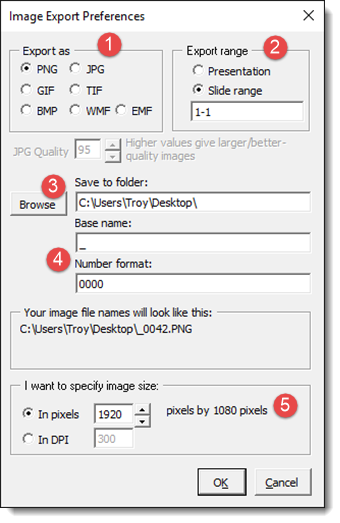
- Select the format for the image (I generally use .png for my images)
- Select a range of slides or the entire presentation (Note: I do like PowerPoint’s option to export the selected slides, something you can manually type in slide numbers here, but a one-click button would be a great addition)
- Easily set a destination for the images
- Create a naming structure for the images (This is great when exporting images from different presenters or multiple versions of the same slides)
- Set the exported image size!
Find out more about PPTools Image Export tool on the web here.
-Troy @ TLC
PPTools – Starter Set
The PPTools Starter Set add-in should be installed on every PowerPoint user’s computer. This venerable add-in (which has remained in use by me since PowerPoint 2003!) has lots of time saving options.

The real power of the PPTools Starter Set is not that it adds new capabilities to PowerPoint, but that it uncovers, or adds, alternate options to built in PowerPoint tools. Here are a few of my favorite options:
![]()
Memorize an Objects Position and Place Objects Exactly: This combination of tools is invaluable. Similar tools are available in other add-ins, but this a great solution. For example, you have a logo that needs to be in the same position on a number of slides – Position where you want it on the first slide, select the logo and click the MEMORIZE tool. Now, go to any other slide, select anything and click the PLACE tool (aka: the hammer – to nail it in place) and it is positioned exactly the same as the first one!

Enlarge and Shrink Text: Yes, PowerPoint has the exact same little A and big A icons and they do the same thing – make text larger or smaller. But, the difference is the native PowerPoint buttons jump the text size based on the preset Office text sizing (18-20-24-28-32-etc.). The PPTools resize text adjusts the text size by 1 pt at a time (19-19-20-21-22-23-etc.), which is exactly what is needed for fine tuning a layout!

Layer Manager: This tool is mostly outdated, but I like to use it as an example of how independent developers are often more in tune with real designer tool needs than the Microsoft Dev team. This amazing tool opens a small dialog and it is basically PowerPoint’s Selection Pane, allowing objects to be arranged in Z order and hidden – but it has been available since PowerPoint 2003!

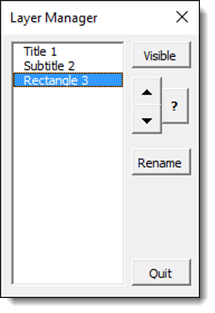
That is a summary of just 3 of the 15+ tools included with the add-in. There is a FREE version and a paid version with additional tools. Find it on the web here.
-Troy @ TLC
The Presentation Podcast Episode – #7 Released Today!
In this episode, Troy, Nolan, and Sandy discuss “Do bullet points can kill an audience?” and the issues bullet lists can cause. Head over to The Presentation Podcast to listen, or add to your favorite Podcast app!
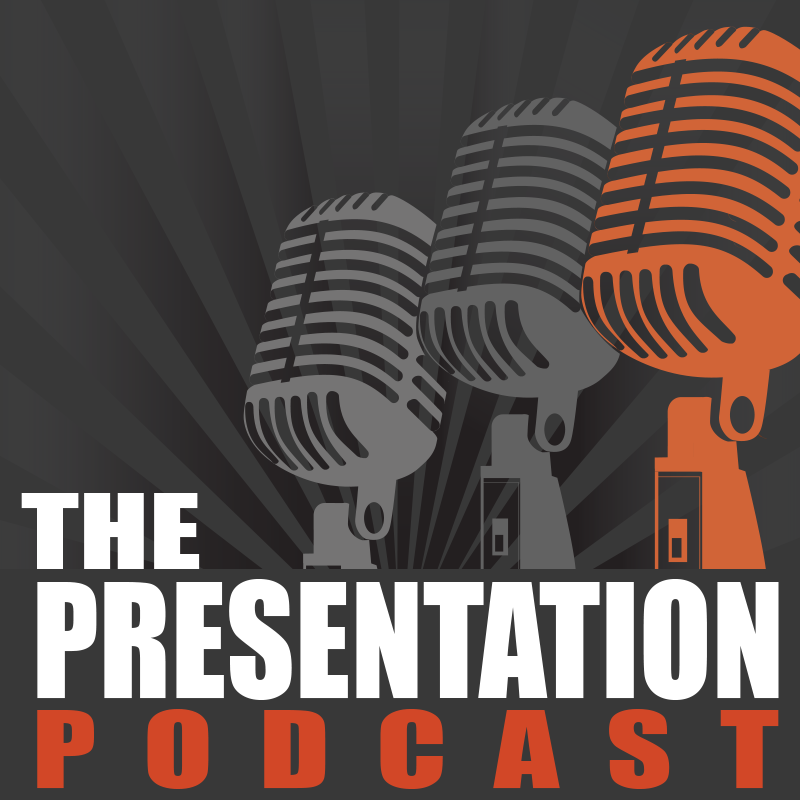
The TLC Custom QAT for PowerPoint
This month, I am focusing on PowerPoint add-ins because the ability to extend PowerPoint’s functionality is one of the biggest attributes that allows it to be a “professional” design tool. The first place to start is PowerPoint’s own extensibility with the QAT – Quick Access Toolbar.
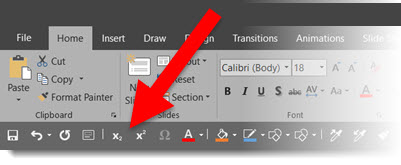
I am a big fan of the Quick Access Toolbar. My first post about it was back in 2009. Then, less than a year later, I became an even bigger fan when PowerPoint 2010 added the ability to export and import pre-made QAT toolbar setups. More recently, at the end of 2015, I became distressed over the QAT when an update to PowerPoint 2016 essentially limited its functionality – which has happily been fixed by the Microsoft PowerPoint Dev team (YAY!!).
The first step in effectively using and setting up the QAT is to move it from above the menus to below. By default, it is above the menu bar (with FILE / HOME / INSERT / etc.) and only has a few buttons. Click the down arrow on the right and select SHOW BELOW THE RIBBON.
At TLC, we have a very customized QAT installed on all of our computers – and has 37 time saving, always available buttons! For this blog post, I am showing our version that only uses standard PowerPoint features (I do run a more customized version that also integrates some tools from 3rd party add-ins – many of which will be in posts this month).
![]()
Click HERE to download the TLC customized QAT (download .zip file, extract, then follow install information below).
To install:
– Go to FILE > OTPIONS
– In the POWERPOINT OPTIONS dialog, go to the QUICK ACCESS TOOLBAR tab
– In the lower right, click the ARROW on the Import/Export button
– Select IMPORT CUSTOMIZATION FILE
– In the FILE OPEN dialog, locate the custom QAT file and click OPEN
– At the warning dialog that existing toolbar setup will be overwritten, click YES
– Customized QAT is now installed!
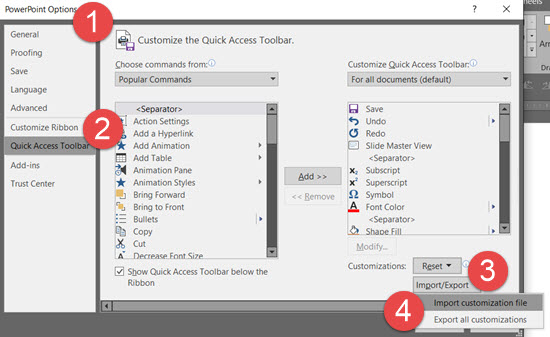
– Troy @ TLC
Can a Mobile Device Project? Yes it can!
There is a lot of talk and excitement about using mobile devices, phone or tablet, to run presentations. And yes, I can confirm it is possible. But the question is – should you use a tablet or smartphone as the presentation “computer?” The answer – it depends on the meeting.

Some presentations require a mobile device, such as a mobile app demo. But for a traditional presentation, if it is a large meeting with AV support, I recommend conforming to the desktop app and handing off a presentation file. This ensures you can focus on the presentation, not the technology setup and function. If it’s a small board room meeting and you feel confident in using newer technology, then mobile devices can be a good option. However, I recommend having a traditional computer, and the presentation on a memory drive – just in case.
Let’s look at the different options currently available to work with when it comes to using mobile devices in presentations. This is a high-level reference and overview of the primary mobile devices that can be used for presentations.
Apple
- iPhone, iPad Tablets and iPod Touch
- Android Phones and Android Tablets
Microsoft
- Windows 8.1 / 10 Mobile and Surface Tablets
Wired and Wireless

There are two types of connection options for getting a presentation from a device to the projector. Both are options. In general, using a wired connection is going to be easiest option, as it has the least technology needs (do to the cables, connect – done).
Wired
The first option is wired connections. This is (obviously) physically connecting a cable to the mobile device. Each device type has a different connector, and then there are multiple options for the AV system you need to figure out (eg. Is the AV system using VGA, HDMI or other display connector?).
iPhone/iPad Connectors
- 30 pin to VGA/HDMI
- Lightning to VGA/HDMI
- USB-C to VGA
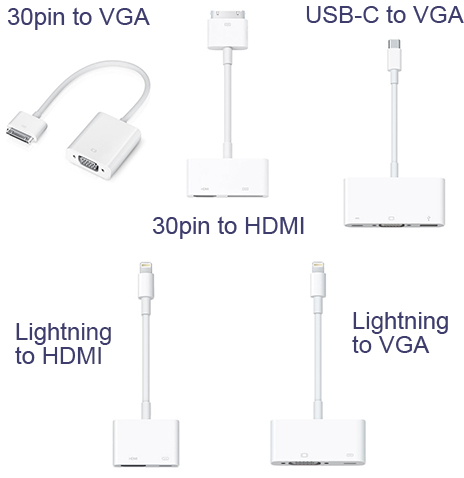
Android Phone / Tablet Connectors
- Mini-HDMI to HDMI or VGA
- HDMI to VGA/HDMI/DVI
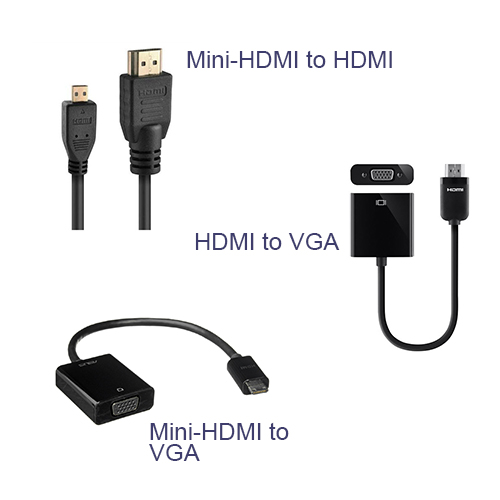
Windows 10 Phone / Tablet Connectors
- Mini HDMI to HDMI/VGA
- Mini DisplayPort (AKA Thunderbolt) to HDMI/VGA/DVI
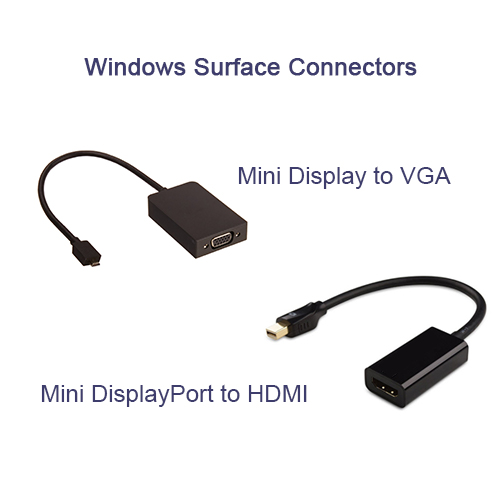
Wireless
The second option is connecting your mobile devices using a wireless system. Keep in mind, most wireless display connectors need WiFi. And the WiFi needs to be fast enough for the presentation to display content and animations smoothly, and it needs to have enough coverage to connect in the meeting meeting room (ie. Not your hotel room or the lobby, but the actual ballroom). Miracast is a direct connection technology, so a WiFi network is not needed.
iOS Devices = Apple TV

Apple devices are easily the most popular and abundant (myself included with an iPhone and iPad). Apple devices need to connect to Apple TV, so you need the physical Apple TV device and a WiFi network for both the IOS device and Apple TV connect to (then the Apple TV connects to the AV System/projector/monitor). AirPlay is the IOS app (built in to all Apple devices) that make the wireless display work.
My opinion on wireless presentations from IOS devices is that they work well, but have a lot of hardware and setup needs.
Android Devices = Google Chromecast

If you use an Android mobile device, the Google Chromecast device is needed. The original Chromecast device was basically a small USB drive with an HDMI connector and additional mini-USB port for power. The new Chromecast device is a bit larger, more in line with an Apple TV size (but still just a USB power). Another option is many SmartTVs are Chromecast-ready and Android devices can stream direct to it with no additional hardware. No matter what Chromecast connector is used, WiFi is needed.
Last, if you are using an Android device, a great app available in the Android Google Play App Store is AllCast, which enables Android devices to also connect to Apple TV, even more SmartTVs and the Amazon Fire TV.
My opinion on Chromecast is that it works, has smaller equipment, has easy setup – but I have been unable to connect it to some larger show AV systems…
Windows 10 Mobile = Miracast WiFi

If you’re a Windows 10 Mobile device user, or Windows 10 desktop, the MiraCast wireless display software is built in. The interesting thing (and good thing), is MiraCast is not a Microsoft technology, but an industry wide wireless display platform that Microsoft has adopted and integrated into ALL Windows 10 devices (Note: It is also available on Windows 8.1 as a download in the Windows App Store). MiraCast is also available on Android devices as a separate app download, and it also works with IOS devices (but is not available through the Apple App store, so only works with “jail break” devices which I hope changes in the future).
My opinion of MiraCast is this works the best of all wireless display options covered. Because it is an open standard, the physical dongle is not limited to one company and I have had some work great and others not work at all. I recommend the Microsoft manufactured device as I have had flawless operation of it (and it is very small like the original Chromecast device). The other really great feature is that MiraCast does not need WiFi, it will connect to any device using a local connection (so it does use WiFi, but not internet enabled WiFi).
I hope the helps with an overview of many mobile device connection options and some of my (sometimes hard-earned) opinions on mobile devices for presentation use.
-Troy @ TLC
